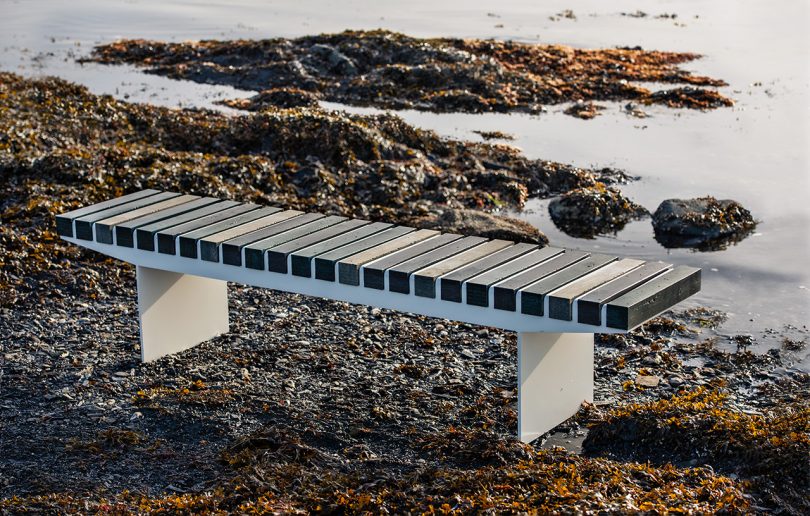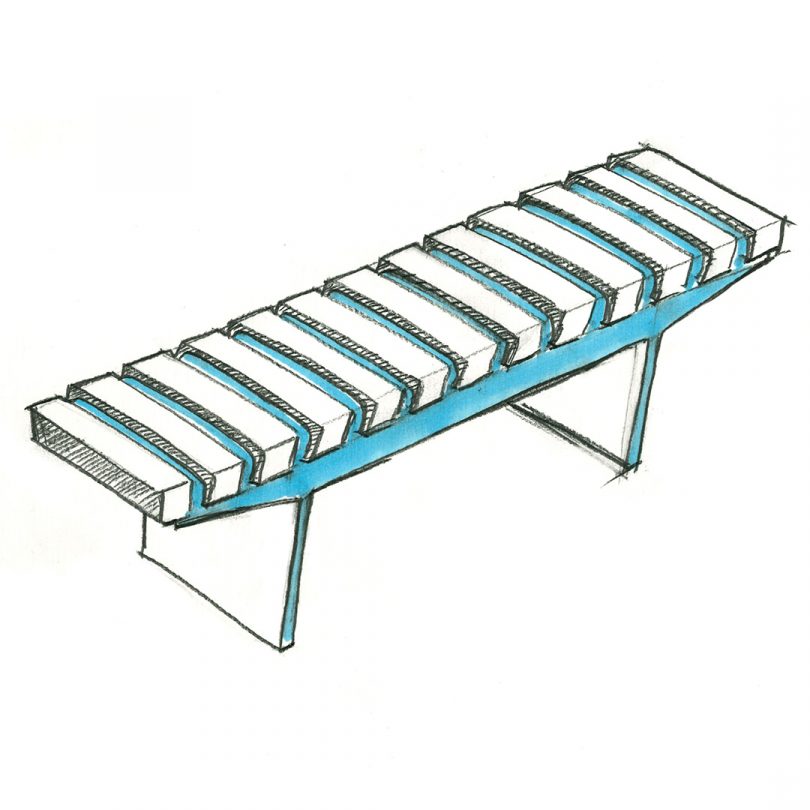Vestre is a Norwegian manufacturer of public furniture that creates social meeting places for millions of people. Owner and CEO Jan Christian Vestre sees the company as a vehicle to do good, following the motto “Everyone can save the world – a little.” The world’s first company to publish Environmental Product Declarations (EPDs) for every product in their catalogue, they work to a triple bottom line, measuring social and environmental, as well as financial results. They have made long term sustainability a prerequisite across their operations and tied this commitment to nine of the UN’s Sustainable Development Goals. We caught up with the head of design, Allan Hagerup, to find out more about what he believes to be the world’s first bench made out of ownerless and recycled ocean plastics.
Tell me a little bit about your childhood, education and background in terms of how you first became interested in creativity, design and sustainability.
I grew up in a remote village in the very far north of Norway. During the long and dark winter months, I developed an interest in drawing and loved to create cartoon characters and design cars. My dad, who runs a graphic design company, inspired my sense of creativity and I spent many hours in his office where he gave me different creative tasks.
I moved to Oslo in 1998 and studied at the Einar Granum Art School for two years before being admitted to a furniture design course at the Oslo National Academy of Arts. I graduated with a master’s degree focusing on the social use of outdoor furniture in public areas and designed “Dialog”, a bench, for which I received the National Award for Design Excellence in 2010.
After I graduated, Vestre put Dialog into production. I started working with Vestre as a freelance designer and eventually accepted a permanent job as a design manager, where I have continued to focus on creating social meeting places. Working at Vestre and seeing their holistic approach to design and sustainable manufacturing has inspired my interest in sustainable design.
How would you describe this project?
In line with Vestre’s broader focus on sustainable manufacturing, we wanted to make a bench from 100% ownerless marine plastics to show that is possible to reuse waste to make great products.
The project is about highlighting the manufacturer’s and the designer’s responsibility to work towards the longevity of raw materials by reusing materials when the initial product is no longer used, and to secure the responsible disposal of unrecyclable materials.
The project is also about recognizing the important work being done by volunteers who are cleaning shores of plastic waste, and how their efforts are at the core of this product.
What inspired this project?
Vestre is part owner of Ogoori, a company that distributes ownerless marine plastics by renting the raw material to manufacturers for use in their products and making sure that the plastic remains in the circular economy. To showcase this new material, I worked with Vestre to create a product for their collection.
The design process has largely been about the plastic itself and the story behind it. This has guided both the form and the design process. The circular economy of reusing material – in this case, material which has so clearly been rejected by society and not recovered through controlled cycles – has also been a focus throughout the whole process. To visualize this cycle, it made sense to create a product that communicates with the ocean. Coast is intended to be placed on a jetty on the waterfront or on a rocky archipelago, so you can sit on the bench and look out over the sea.
The plastic’s history is also reflected in the way the shape of the bench borrows its design and theme from the marine environment. From the front, you can make out the outline of a boat’s hull, and the plastic parts lie in a row, submerged in a protective steel frame, giving the impression of floating on the surface. The steel frame extends upwards on thin legs and lifts the plastic material onto a pedestal. The different shades of green and grey in the plastic material came about as a result of the combination of different colors of plastic collected and at the same time, reflect the color of the sea.
What waste (and other) materials are you using, how did you select those particular materials and how do you source them?
Coast has a frame made from steel that has been hot-dip galvanized and powder coated. The steel is sourced from Sweden and has an average of 30% lower emissions than the world average for steel production. The seating surface is made of plastic collected from Norwegian shores, where the ownerless plastic accumulates, destroying nature and natural cycles.
When did you first become interested in using waste as raw material and what motivated this decision?
To be honest, I have always been hesitant about using plastic components when designing products, preferring to use natural products such as steel and wood. However, when Vestre started looking at reusing marine plastics it was a material that inspired me. As Vestre doesn’t use plastic in their products it made even more sense. By only using marine plastic, we are helping with the problem without adding to it.
What processes does the material have to undergo to become the finished product?
The marine plastic is sorted by type and washed, dried and ground into pellets. These pellets can be used in the same manufacturing processes as new plastics. However, the quality of the plastic is naturally not as consistent and durable as with new purpose-built plastic compounds. The different types of plastics are molded into the seat slats used in the product. Because the plastic is less durable, I wanted to make it a replaceable part of the bench and not part of the mainframe.
What happens to your products at the end of their life – can they go back into the circular economy?
The plastic pellets are not sold but rented to manufacturers and branded with a QR code. This ensures that the replaceable slats used are returned for new cycles of use.
How did you feel the first time you saw the transformation from waste material to product/prototype?
It’s an inspiring and gratifying task to design a bench that uses plastic collected from beaches with the help of volunteers. So it feels good to have created the first bench from this material for Vestre, and to contribute to sustainable development with a product that will be accessible to everyone.
I also marveled that something that has been thrown away and floated for a long time in the sea could look so interesting and beautiful. The decision to let the material determine the look of the bench and mix the qualities of plastic slats randomly by availability created a surprising and interesting color texture – a design benefit that came from using waste as raw material.
How have people reacted to this project?
People are in general very enthusiastic and it is the same with Vestre`s customers who are interested in using both the bench and the raw material for their projects. It is especially fun to hear that the bench has inspired the teams cleaning up the shores.
How do you feel opinions towards waste as a raw material are changing?
I think that there is a strong feeling of responsibility and concern for the environment that is making people question the throw-away culture. These type of products enable people to make responsible choices. If it is possible to make aesthetically beautiful things from waste, then it adds meaning and value to the product rather than detracting from it.
What do you think the future holds for waste as a raw material?
There are many efforts being made to reuse materials, and it is trending both in product design and architecture. Hopefully, this bench can play a small part in helping this movement along.
from WordPress https://connorrenwickblog.wordpress.com/2021/03/16/vestre-turns-ownerless-ocean-plastics-into-public-benches/












No comments:
Post a Comment